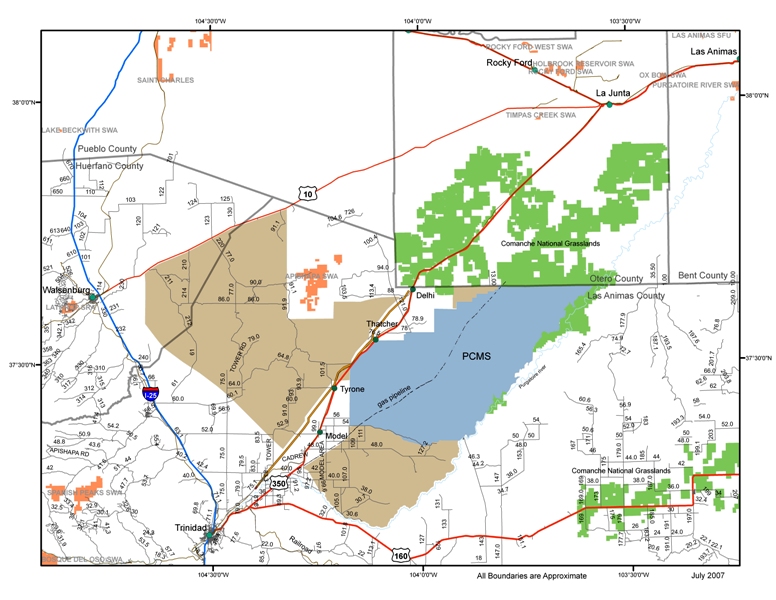 |
| Blue is the current PCMS, brown the proposed expansion area. Green areas are the Comanche National Grasslands (Wikicommons). |
Fort Carson, formed during World War II (at the begging of city fathers who wanted soldiers' pay spent in Colorado Springs), was created by expropriating ranch land to create the 137,000-acre military reservation.
But it was not enough anymore, the Army said. They wanted another training area close enough to shuttle units back and forth. Various locations were suggested: South Park, the San Luis Valley, the High Plains.
The High Plains "won," and a new round of condemnations created the 235,896-acre Piñon Canyon Maneuver Site along the Purgatory River.
Some landowners took the money and ran, while others fought futilely against the federal government.
It's possible to hunt on PCMS, and my friend Eric and I took advantage of that to explore various archaeological sites, old and new. I remember walking into an abandoned house in the late 1980s and finding, for example, a 1977 Sears Roebuck catalog still lying on a kitchen counter, while kids' toys littered the living room floor. It was a sad scene.
At the same time, I had to admit that Army ownership gave those of us who jumped through a couple of bureaucratic hoops opportunities to explore country that we never could have entered before.
The Army's civilian wildlife specialists kept windmills pumping water for deer and antelope and lobbied to keep training activities out of "sensitive areas." One of them told me that they would mark off small wetlands, for example, with engineer's tape, and the troops were supposed to treat them as "minefields."
An area containing the now-famous dinosaur trackway was transferred to the U.S. Forest Service and opened to the public.
But generals kept hinting that they needed still more land — more than 400,000 acres — and local residents lobbied Colorado politicians to stop that. Homemade signs saying "This land is not for sale to the Army" went up in Otero, Las Animas, and other counties.
Late last November (I missed this at the time), the Army backed down.
At the urging of Sen. Mark Udall, a Boulder County Democrat, Army Assistant Secretary Katherine Hammack used the paperwork equivalent of a wooden stake to kill expansion plans for the 235,000-acre training site.The Army's reason is that fewer troops means less need for training. But then they would never admit that the years of bad publicity, political conflict, and hard feelings mattered.
"It's kind of an emotional moment," said Las Animas County Commissioner Gary Hill, a rancher and neighbor of the training area who has been at war with the Army over expansion for years.
Furthermore, generals and assistant secretaries come and go, but the expansion plan, once written, can last for decades.
No comments:
Post a Comment